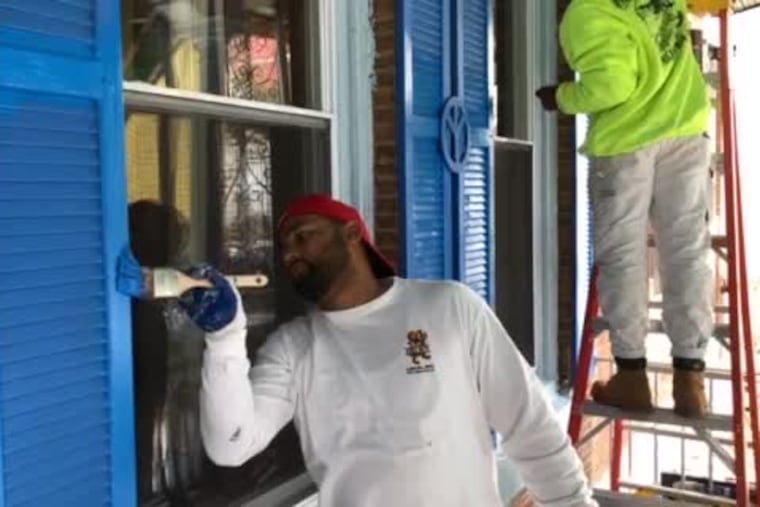Residents who went through ‘horrible things’ in North Philly police shootout get their homes repaired
Walking past bullet holes in his home would remind Kenneth Foreman of the August gunfire. Now, his home is repaired and he says he can start healing.

Kenneth Foreman opened his front door Tuesday morning, saw the bullet holes in his windows, and shivered.
The holes have been visible since Aug. 14, when Maurice Hill, armed with an AR-15 assault rifle, barricaded himself in the house across the street and engaged in an hours-long shootout with police as a drug raid went awry. Passing this violent reminder every day reminds Foreman, 76, of the swarm of officers on his usually quiet block and the thunder of gunfire.
But Tuesday was different, Foreman said. It was finally time for his windows to be replaced.
Volunteers from District Council 21 of the International Union of Painters and Allied Trades were fixing up Foreman’s home and two others across the street from where the shootout happened.
“Today, I feel like I’m born again,” Foreman said. “I feel real happy. I see love. I see unity. I see harmony.”
It’s been more than two months since the largest mass shooting of Philadelphia police officers in decades. Organizers from the union walked around the street Tuesday, talking with Foreman and other residents about the work they were doing, and offering pretzels and coffee.
“I can’t thank you enough,” Foreman said to District Council 21 organizer Roberto Rios as workers were wrapping up for the day.
“Well,” Rios said, “you went through some horrible things.”
After the shootout, residents found themselves living in a weeks-long crime scene as investigators examined the more than 100 rounds of bullets fired during the standoff, impounded cars for evidence, and inspected bullet holes in homes.
But officials and the community have also come together to repair the street that was riddled with bullet holes. The house of the standoff is now boarded up; representatives from the city’s Community Life Improvement Program painted its exterior with a bright blue door. There is a detailed, almost whimsical, painting where the windows used to be — curtains from candles on the windowsill, a bright light shining in a dark room. There was a block party last month at which kids played pickup basketball with police officers. The repairs were the next step.
“This neighborhood,” said block captain Cynthia Muse, “is going to come up and be better because of this.”
Mayor Jim Kenney stopped by during the work, which took place on Election Day, shaking hands with police officers and volunteers, and listened to residents.
“Fourteen bullet holes,” Foreman told Kenney about the damage his home took during the shootout.
Foreman has lived in his home for about 15 years, and said he often thinks about what happened across the street. That summer afternoon, Foreman said, he walked outside when officers yelled to him over gunfire: “Get inside! Get inside!”
He moved as fast as he could to the kitchen in the back of his house, but quickly realized that it might not have been safe either. He ran upstairs to his bedroom and lay flat on his bed, listening to the more than 100 rounds of sporadic gunfire during the standoff, which lasted for 7½ hours.
He shakes thinking about the fear he felt during those hours. Ever since, hearing a car backfire, the drop of a bowl, and any sudden, loud noise makes him jump.
» READ MORE: The North Philly block the morning after police shooting: ‘Today we have no children' in the streets
“This block was really something like we’ve never seen before, and unfortunately it is something that unfolded on national television, so the world was kind of following,” acting Police Commissioner Christine M. Coulter said. The repairs, she said, will “get rid of some of those negative reminders.… Replacing glass and fixing up things and beautifying things just starts bringing the block back to what its new normal will be.”
Even with cosmetic changes to homes, Jondhi Harrell, the executive director of TCRC Philly, an organization with a nearby community healing center, said the neighborhood has a long way to go. Children on lockdown at the day care were traumatized, young people were forced out of their homes for hours, and those who sheltered in place can recall the gunfire, he said.
“The damage that was done to a neighborhood that was looked at by the city, and the rest of the country, as something less than, a place where police are shot …,” he said. “The level of healing that has to be done in the neighborhood hasn’t happened.”
» READ MORE: 'The cops' lives matter and these kids don’t. It’s not fair.' | Helen Ubiñas
While home repairs continued and news vans came and went Tuesday, Ana Cruz, 28, stayed in the same place she was when the shootout happened: her second-floor, one-bedroom apartment.
She didn’t care much about seeing the repairs. She’s a renter and more concerned with caring for her baby, Jayliana Alston, who turned 2 months old Tuesday.
Holding sleeping Jayliana, Cruz pointed out the window in her bedroom, where she said officers climbed inside during the shootout. At the time, she was terrified, confused, and very pregnant.
She remembered lying on her bedroom floor, where her baby’s crib is now, and thought the anxiety would make her go into labor amid the gunfire. Three weeks after the shooting, on Sept. 5, Jayliana was born.
Cruz posted a photo on Instagram of her baby in her arms at the hospital and wrote: “This day was a blessing.”